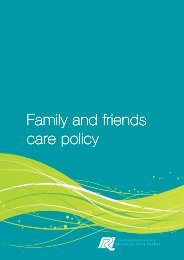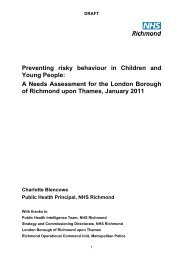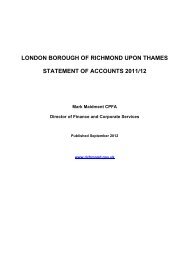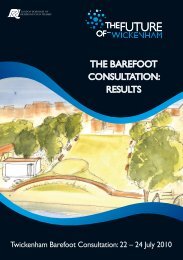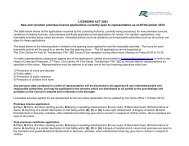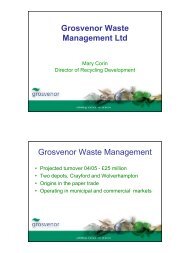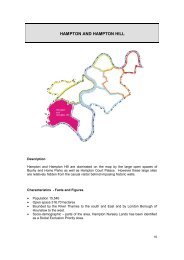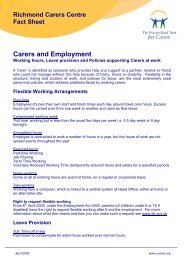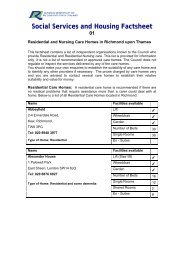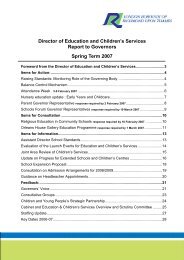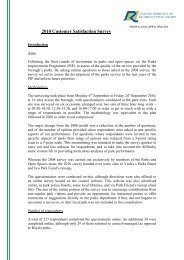Results report 2012 - London Borough of Richmond upon Thames
Results report 2012 - London Borough of Richmond upon Thames
Results report 2012 - London Borough of Richmond upon Thames
You also want an ePaper? Increase the reach of your titles
YUMPU automatically turns print PDFs into web optimized ePapers that Google loves.
<strong>London</strong> <strong>Borough</strong> <strong>of</strong> <strong>Richmond</strong> <strong>upon</strong> <strong>Thames</strong> Residents’ Survey<br />
October <strong>2012</strong>
<strong>London</strong> <strong>Borough</strong> <strong>of</strong> <strong>Richmond</strong> <strong>upon</strong> <strong>Thames</strong> Residents’ Survey October <strong>2012</strong><br />
Contents<br />
Introduction ....................................................................................................... 3<br />
Data .................................................................................................................... 3<br />
Methodology...................................................................................................... 3<br />
Executive Summary .......................................................................................... 4<br />
1. Rating the Council......................................................................................... 7<br />
2. Satisfaction with the area........................................................................... 10<br />
3. Service satisfaction and priorities............................................................. 19<br />
4. Communications and Engagement ........................................................... 25<br />
5. Managing the Council’s Budget................................................................. 37<br />
Statistical Reliability ....................................................................................... 39<br />
2
<strong>London</strong> <strong>Borough</strong> <strong>of</strong> <strong>Richmond</strong> <strong>upon</strong> <strong>Thames</strong> Residents’ Survey October <strong>2012</strong><br />
Introduction<br />
In September/October <strong>2012</strong> the <strong>London</strong> <strong>Borough</strong> <strong>of</strong> <strong>Richmond</strong> <strong>upon</strong> <strong>Thames</strong> commissioned an<br />
independent research company to carry out a telephone survey on their behalf. The aims <strong>of</strong> this survey<br />
were to gather the views <strong>of</strong> borough residents on a number <strong>of</strong> issues, including satisfaction with the<br />
Council and its services, the local area, crime and community. This information helps the Council to<br />
understand the views and priorities <strong>of</strong> local residents and will be taken into account when decisions are<br />
made about Council plans and services.<br />
It is intended that the survey will be repeated on an annual basis so that the Council can track<br />
residents’ views over time and ensure that they continue to be taken into account.<br />
Data<br />
<strong>Results</strong> in this <strong>report</strong> are based on telephone interviews with 1,400 <strong>Richmond</strong> borough residents aged<br />
16 and over and interviewed between 27 th September and 16 th October <strong>2012</strong>.<br />
Where appropriate, the results <strong>of</strong> the residents’ survey are compared to data from the following<br />
sources;<br />
• All in One Survey: 13,585 responses <strong>of</strong> <strong>London</strong> <strong>Borough</strong> <strong>of</strong> <strong>Richmond</strong> <strong>upon</strong> <strong>Thames</strong> households,<br />
between 8 th November – 10 th December 2010.<br />
• LGA Data: Telephone survey <strong>of</strong> 1,006 GB adults aged 18+, between 31 st August and 2 nd<br />
September <strong>2012</strong><br />
• Ipsos MediaCT Tech Tracker Quarterly Release Q2 <strong>2012</strong>: 1,000 interviews GB adults aged 15+<br />
Findings show resident perceptions which may be different to actual service performance.<br />
Methodology<br />
Interviews were conducted using a Random Digital Dialing (RDD) sampling approach, which involves<br />
the use <strong>of</strong> computers to randomly generate the last few digits <strong>of</strong> known telephone numbers covering<br />
the area (provided from the telephone exchange). The use <strong>of</strong> this method ensures that everyone with a<br />
phone line in the borough has a fair and equal chance to take part in the survey. Quotas were set to<br />
ensure that the population balance in the borough was accurately reflected – these quotas were based<br />
on 2011 census data where available, and set by age, gender, working status and population size <strong>of</strong><br />
each village area.<br />
In each village area, a minimum number <strong>of</strong> interviews were set in relation to the population size.The<br />
lowest sample was in Strawberry Hill, where 44 interviews were achieved, compared to the highest in<br />
Teddington where 168 interviews were achieved. The weighted data ensures the figures are reliable,<br />
and more information is available in the appendices.<br />
3
<strong>London</strong> <strong>Borough</strong> <strong>of</strong> <strong>Richmond</strong> <strong>upon</strong> <strong>Thames</strong> Residents’ Survey October <strong>2012</strong><br />
The RDD method ensures that calls are confidential as no personal information such as name or<br />
address <strong>of</strong> respondents is known by the interviewer or by the Council. By law RDD numbers can<br />
include ex-directory and TPS (Telephone Preference Service) registered numbers as the calls are for<br />
research purposes and not marketing calls. To allay any concerns that residents may have that the<br />
calls were genuine the Council website carried an announcement about the survey, and interviewers<br />
<strong>of</strong>fered any concerned respondents the option <strong>of</strong> a callback from the Community Engagement Team at<br />
the Council.<br />
Executive Summary<br />
Rating the Council<br />
<strong>Richmond</strong> borough residents rate the Council highly, especially when the survey results are compared<br />
with the national picture. Three quarters (76%) <strong>of</strong> respondents say they are satisfied with the way the<br />
Council runs things - this figure is higher than the national average <strong>of</strong> 72%. Three quarters (73%) <strong>of</strong><br />
respondents say they trust the Council - this is 12% higher than the national average <strong>of</strong> 61%. Almost<br />
half (48%) believe the Council provides good value for money (46% nationally).<br />
Overall figures for how well informed <strong>Richmond</strong> Council keeps residents about the services and<br />
benefits it provides are lower than the national average – 57% compared to 66% nationally. Further<br />
breakdown <strong>of</strong> these figures by village show that residents in Strawberry Hill feel the most informed<br />
(68%) and those in Hampton Wick feel the least informed (49%).<br />
Satisfaction with the area<br />
Over nine in ten (93%) <strong>of</strong> residents say they are satisfied with their local area as a place to live. This is<br />
in line with the results <strong>of</strong> the All in One survey 2010 - 92% <strong>of</strong> respondents to that survey agreed that<br />
their local area was a good place to live. Both scores are significantly higher than the national average<br />
<strong>of</strong> 84%.<br />
Three quarters (76%) <strong>of</strong> residents agree that the local area is a place where people from different<br />
backgrounds get on well together, and this figure rises to over 80% in Hampton Wick, Kew, Strawberry<br />
Hill, Twickenham and Whitton.<br />
Residents <strong>report</strong> a high level <strong>of</strong> satisfaction with local high streets in the <strong>Richmond</strong> borough. Nearly<br />
four in five (78%) say they are satisfied with their local high street overall and nearly nine in ten (88%)<br />
say they are satisfied with the safety <strong>of</strong> the area.<br />
Two-thirds (67%) <strong>of</strong> residents feel the police and other local public services are successfully dealing<br />
with crime and anti-social behaviour, with 6% <strong>of</strong> residents stating they have been a victim <strong>of</strong> crime in<br />
the last month.<br />
4
<strong>London</strong> <strong>Borough</strong> <strong>of</strong> <strong>Richmond</strong> <strong>upon</strong> <strong>Thames</strong> Residents’ Survey October <strong>2012</strong><br />
Service satisfaction and priorities<br />
Nine in ten (90%) users <strong>of</strong> parks, open spaces and play areas say they are satisfied with these<br />
services. Parks are an important asset for the borough and a priority for residents - in the 2010 All in<br />
One survey 73% <strong>of</strong> residents mentioned parks and open spaces as one <strong>of</strong> the three most important<br />
factors in making their area a good place to live.<br />
There is a high level <strong>of</strong> satisfaction amongst residents for many <strong>of</strong> the services they receive - refuse<br />
collection, primary schools, public transport and recycling services all receive satisfaction ratings <strong>of</strong><br />
over 80% from service users. Residents in Strawberry Hill, Kew and <strong>Richmond</strong> consistently record<br />
higher service satisfaction scores than residents in other villages.<br />
The most common issue cited by residents as a problem in the area is congestion - half (52%) <strong>of</strong><br />
residents agree congestion is a problem, rising to 74% in East Sheen and 73% in Mortlake. This in line<br />
with results from the 2010 All in One survey, where 34% <strong>of</strong> respondents mentioned traffic/levels <strong>of</strong><br />
congestion as the top issue they thought needed improving in the local area.<br />
Parking services and roads and pavements maintenance are the services with which respondents are<br />
the least satisfied. 24% <strong>of</strong> respondents think that road and pavement maintenance are the most<br />
important services to improve in the next 12 months and 20% believe that parking services need<br />
improving the most. These results reflect the findings <strong>of</strong> the All in One and reinforce the Council’s<br />
decisions to introduce fairer parking charges for residents and the new annual Community Roads and<br />
Pavement Fund.<br />
Communications and engagement<br />
Two thirds (68%) <strong>of</strong> residents agree that the Council acts on the concerns <strong>of</strong> local residents – this is<br />
6% higher than the national average (62%). 40% feel that the Council takes into account residents’<br />
views and 31% feel they can influence the decisions that the Council makes. This is a 12% increase on<br />
the response to the same question in the All in One survey, although due to the methodological<br />
differences between a postal and telephone survey, some level <strong>of</strong> difference should be expected.<br />
One third (34%) <strong>of</strong> residents say they have contacted the Council in the last month. 64% <strong>of</strong> those say<br />
they were satisfied with the way the Council handled their enquiry, while 61% say they were satisfied<br />
with the final outcome.<br />
Almost half <strong>of</strong> residents say they have seen the council website (47%) , nearly one quarter (23%) have<br />
seen a MyVillage newsletter and two thirds have seen the <strong>Richmond</strong> and Twickenham Times in the<br />
last six months. Those who have seen any <strong>of</strong> these communications channels are more likely to agree<br />
that they feel informed about the services and benefits the council provides.<br />
<strong>Richmond</strong> residents are community-minded, with almost a third (30%) saying they spend time doing<br />
something to help improve their community or neighbourhood, while two thirds (66%) say they are<br />
interested in receiving more information to help them do more to help improve their community or<br />
neighbourhood.<br />
5
<strong>London</strong> <strong>Borough</strong> <strong>of</strong> <strong>Richmond</strong> <strong>upon</strong> <strong>Thames</strong> Residents’ Survey October <strong>2012</strong><br />
Setting the Council’s budget<br />
Three quarters (74%) <strong>of</strong> respondents agree that the Council should freeze council tax as a means <strong>of</strong><br />
managing its budget during the current difficult economic times. Opinion is split on whether the Council<br />
should increase charging for some services to help cover costs (36% agree vs 35% who disagree) or<br />
reduce spending by reducing some services (32% agree vs. 35% who disagree).<br />
6
<strong>London</strong> <strong>Borough</strong> <strong>of</strong> <strong>Richmond</strong> <strong>upon</strong> <strong>Thames</strong> Residents’ Survey October <strong>2012</strong><br />
1. Rating the Council<br />
<strong>Richmond</strong> borough residents rate the Council highly, especially when the survey results are compared<br />
with those <strong>of</strong> other Councils nationally. Over three quarters (76%) <strong>of</strong> respondents say they are satisfied<br />
with the way the Council runs things - this figure is higher than the national average <strong>of</strong> 72%. Almost<br />
three quarters (73%) <strong>of</strong> residents say they trust the Council - this is 12% higher than the national<br />
average <strong>of</strong> 61%. Nearly half (48%) believe the Council provides good value for money (46%<br />
nationally).<br />
Overall figures for how well informed <strong>Richmond</strong> Council keeps residents about the services and<br />
benefits it provides are lower than the national average – 57% compared to 66% nationally. This area<br />
in particular is covered in Chapter 3 <strong>of</strong> this <strong>report</strong>.<br />
Figure 1.1: Rating the Council compared to the national average<br />
<strong>Richmond</strong><br />
National Average<br />
Satisfaction with council<br />
76%<br />
72%<br />
Trust council<br />
73%<br />
61%<br />
Informed about services and benefits<br />
57%<br />
66%<br />
Value for money<br />
48%<br />
46%<br />
Question: Overall, how satisfied or dissatisfied are you with the way <strong>Richmond</strong> Council runs<br />
things?/To what extent do you agree or disagree <strong>Richmond</strong> Council provides good value for<br />
money?/How much do you trust <strong>Richmond</strong> Council?/Overall how well informed do you think <strong>Richmond</strong><br />
Council keeps residents about the services and benefits it provides?<br />
Source: <strong>Richmond</strong> Residents’ Survey <strong>2012</strong> compared with LGA data<br />
7
<strong>London</strong> <strong>Borough</strong> <strong>of</strong> <strong>Richmond</strong> <strong>upon</strong> <strong>Thames</strong> Residents’ Survey October <strong>2012</strong><br />
Strawberry Hill and Whitton village areas had the highest percentage <strong>of</strong> respondents satisfied with the<br />
way the Council runs things (82% and 83% respectively). It is worth nothing though that even the<br />
lowest satisfaction score recorded in a village is comparable with the national average (70% in<br />
Hampton Hill compared to 72% nationally). Similarly Hampton Hill has the lowest percentage <strong>of</strong><br />
respondents who say they trust the Council, at 64%, but this figure is still above the national average <strong>of</strong><br />
61%.<br />
Table 1.2: Rating the Council by village<br />
Average<br />
Villages with highest<br />
perception scores<br />
Villages with the lowest<br />
perception scores<br />
Satisfaction with<br />
the council<br />
77% Whitton<br />
(83%)<br />
Strawberry<br />
Hill (82%)<br />
Hampton Hill<br />
(70%)<br />
Barnes<br />
(72%)<br />
Trust the council 73% Strawberry<br />
Hill (85%)<br />
<strong>Richmond</strong><br />
(79%)<br />
Hampton Hill<br />
(64%)<br />
Twickenham<br />
(68%)<br />
Value for money 48% Strawberry<br />
Hill (61%)<br />
Informed about<br />
services and<br />
benefits<br />
57% Strawberry<br />
Hill (68%)<br />
Kew (57%)<br />
Whitton<br />
(66%)<br />
Hampton Hill<br />
& Hampton<br />
Wick (41%)<br />
Hampton Wick<br />
(49%)<br />
East Sheen<br />
(39%)<br />
St. Margarets<br />
(51%)<br />
8
<strong>London</strong> <strong>Borough</strong> <strong>of</strong> <strong>Richmond</strong> <strong>upon</strong> <strong>Thames</strong> Residents’ Survey October <strong>2012</strong><br />
Table 1.3: Rating the Council by demographics<br />
Figures highlighted in yellow indicate statistically significant differences.<br />
Satisfaction with<br />
the council %<br />
Good value<br />
for money %<br />
Trust the<br />
council<br />
%<br />
Feel informed about<br />
services and benefits<br />
%<br />
Average 77% 48% 74% 57%<br />
Male 77% 50% 75% 60%*<br />
Female 76% 46% 73% 54%<br />
16-29 81% 47% 79% 51%<br />
30-49 77% 47% 73% 56%<br />
50-64 71% 42% 71% 59%<br />
65+ 77% 58%* 75% 63%*<br />
White 76% 49%* 74% 58%*<br />
BME 77% 39% 70% 49%<br />
Work FT 77% 48% 74% 55%<br />
Not working FT 75% 48% 74% 59%<br />
Lived 0-12 months 71% 49% 64% 45%<br />
in <strong>Richmond</strong><br />
Lived 1-5 years in 87%* 52% 81%* 58%<br />
<strong>Richmond</strong><br />
Lived 6+ years in 74% 47% 73% 57%<br />
<strong>Richmond</strong><br />
Barnes 72% 45% 74% 59%<br />
East Sheen 80% 39% 77% 56%<br />
Ham & Petersham 74% 44% 69% 52%<br />
Hampton 74% 43% 71% 54%<br />
Hampton Hill 70% 41% 64% 57%<br />
Hampton Wick 78% 41% 72% 49%<br />
Kew 78% 57%* 76% 64%<br />
Mortlake 80% 50% 75% 61%<br />
<strong>Richmond</strong> 78% 48% 79%* 58%<br />
St Margarets 74% 46% 72% 51%<br />
Strawberry Hill 82% 61% 85%* 68%<br />
Teddington 75% 49% 76% 53%<br />
Twickenham 74% 52% 68% 54%<br />
Whitton 83%* 50% 74% 66%*<br />
9
<strong>London</strong> <strong>Borough</strong> <strong>of</strong> <strong>Richmond</strong> <strong>upon</strong> <strong>Thames</strong> Residents’ Survey October <strong>2012</strong><br />
2. Satisfaction with the area<br />
2.1: Community<br />
Over nine in ten (93%) <strong>of</strong> residents say they are satisfied with their local area. This is in line with the<br />
2010 All in One survey result where 92% <strong>of</strong> residents said their local area was a good place to live.<br />
Both scores are higher than the average rating given across the UK (84%).<br />
Three quarters (76%) agree that the local area is a place where people from different backgrounds get<br />
on well together, while only 2% disagree.<br />
Figure 2.1.1: Satisfaction with area as a place to live and how well people get on together<br />
Q. Overall how satisfied or dissatisfied are<br />
you with your local area as a place to live?<br />
Q. To what extent do you agree or disagree<br />
that your local area is a place where people<br />
from different backgrounds get on well<br />
together?<br />
Question: Overall how satisfied or dissatisfied are you with your local area as a place to live?/ To what<br />
extent do you agree or disagree that your local area is a place where people from different<br />
backgrounds get on well together?<br />
Source: <strong>Richmond</strong> Residents’ Survey <strong>2012</strong><br />
10
<strong>London</strong> <strong>Borough</strong> <strong>of</strong> <strong>Richmond</strong> <strong>upon</strong> <strong>Thames</strong> Residents’ Survey October <strong>2012</strong><br />
Table 2.1.2: Satisfaction with area as a place to live and and how well people get on together by<br />
demographics<br />
Figures highlighted in yellow indicate statistically significant differences.<br />
Satisfied with local area as<br />
a place to live %<br />
People from different backgrounds<br />
get on well together %<br />
Average 93% 76%<br />
Male 93% 78%<br />
Female 93% 75%<br />
16-29 91% 74%<br />
30-49 93% 77%<br />
50-64 93% 79%<br />
65+ 94% 75%<br />
White 93% 77%<br />
BME 90% 77%<br />
Working FT 94% 77%<br />
Not working FT 92% 76%<br />
Lived for 0-12 months in<br />
96% 69%<br />
<strong>Richmond</strong><br />
Lived for 1-5 years in<br />
96%* 74%<br />
<strong>Richmond</strong><br />
Lived for 6+ years in<br />
92% 77%<br />
<strong>Richmond</strong><br />
Barnes 93% 70%<br />
East Sheen 94% 71%<br />
Ham & Petersham 94% 70%<br />
Hampton 92% 78%<br />
Hampton Hill 100%* 74%<br />
Hampton Wick 86% 81%<br />
Kew 97%* 81%*<br />
Mortlake 93% 77%<br />
<strong>Richmond</strong> 94% 78%<br />
St Margarets 88% 68%<br />
Strawberry Hill 96% 85%*<br />
Teddington 97%* 75%<br />
Twickenham 90% 80%*<br />
Whitton 88% 85%*<br />
11
<strong>London</strong> <strong>Borough</strong> <strong>of</strong> <strong>Richmond</strong> <strong>upon</strong> <strong>Thames</strong> Residents’ Survey October <strong>2012</strong><br />
2.2: Satisfaction with local high street<br />
Most residents say they are satisfied with their local high street. Nearly nine in ten (88%) say they are<br />
satisfied with the safety <strong>of</strong> the area and nearly four in five (78%) say they are satisfied with their local<br />
high street overall.<br />
Figure 2.2.1: Rating local high streets<br />
Th e safety <strong>of</strong> the area<br />
88%<br />
You r local high street overall<br />
78%<br />
Th e appearance <strong>of</strong> the high street<br />
77%<br />
Th e range <strong>of</strong> shops available<br />
69%<br />
Question: Thinking about your local high street, how satisfied or dissatisfied are you with the<br />
following? (% satisfied shown)<br />
Source: <strong>Richmond</strong> Residents’ Survey <strong>2012</strong><br />
Overall resident satisfaction with the local high street is 78%, but this figure rises to 90% in Hampton<br />
Hill, 87% in East Sheen and 86% in Kew. Four in five (77%) <strong>of</strong> residents are satisfied with the<br />
appearance <strong>of</strong> their high street, rising to 90% in <strong>Richmond</strong>, 87% in Kew and 86% in Teddington.<br />
Residents who are the least satisfied with the appearance <strong>of</strong> their high street are those living in<br />
Twickenham (67%) and St Margarets (66%).<br />
Seven in ten (69%) <strong>of</strong> residents say they are satisfied with the range <strong>of</strong> shops available in their local<br />
high street, rising to 81% <strong>of</strong> residents in <strong>Richmond</strong>, 76% in Kew and 74% in Teddington. The villages<br />
where residents are least satisfied with the range <strong>of</strong> shops are Hampton Wick (61%) and Twickenham<br />
(60%).<br />
12
<strong>London</strong> <strong>Borough</strong> <strong>of</strong> <strong>Richmond</strong> <strong>upon</strong> <strong>Thames</strong> Residents’ Survey October <strong>2012</strong><br />
Table 2.2.2: Satisfaction with local high street by demographics<br />
Figures highlighted in yellow indicate statistically significant differences.<br />
Satisfied with<br />
local high<br />
street %<br />
Satisfied with Satisfied with the<br />
appearance <strong>of</strong> high range <strong>of</strong> shops<br />
street %<br />
available %<br />
Satisfied with<br />
the safety <strong>of</strong><br />
the area %<br />
Average 78% 77% 69% 88%<br />
Male 77% 78% 69% 88%<br />
Female 78% 77% 69% 87%<br />
16-29 78% 80% 70% 87%<br />
30-49 79% 77% 68% 89%<br />
50-64 79% 78% 70% 88%<br />
65+ 73% 75% 67% 84%<br />
White 78% 77% 68% 88%<br />
BME 78% 78% 73% 84%<br />
Working FT 78% 78% 70% 90%*<br />
Not working FT 77% 77% 67% 85%<br />
Lived for 0-12 96%* 80% 79% 98%*<br />
Lived for 1-5 79% 80% 70% 90%<br />
Lived for 6+ years 77% 77% 68% 87%<br />
Barnes 71% 74% 71%* 89%<br />
East Sheen 87%* 77% 66% 91%*<br />
Ham & Petersham 81%* 89%* 66% 80%<br />
Hampton 74% 72% 67% 83%<br />
Hampton Hill 90%* 70% 73% 85%<br />
Hampton Wick 83%* 78% 61% 90%<br />
Kew 86%* 87%* 76%* 91%*<br />
Mortlake 85%* 70% 69% 92%*<br />
<strong>Richmond</strong> 84%* 90%* 81%* 92%*<br />
St Margarets 70% 66% 63% 88%<br />
Strawberry Hill 79% 73% 65% 90%<br />
Teddington 81%* 86%* 74%* 91%*<br />
Twickenham 67% 67% 60% 82%<br />
Whitton 74% 73% 57% 85%<br />
13
<strong>London</strong> <strong>Borough</strong> <strong>of</strong> <strong>Richmond</strong> <strong>upon</strong> <strong>Thames</strong> Residents’ Survey October <strong>2012</strong><br />
2.3: Perceptions <strong>of</strong> changes to high streets over time<br />
Overall, most residents (57%) say they feel their local high street has stayed the same over the last 12<br />
months. A quarter (24%) say they feel their local high street has got better, rising to 38% in Whitton,<br />
33% in St Margarets and 31% in Strawberry Hill. 16% <strong>of</strong> residents perceive that their high street has<br />
got worse, rising to 23% in Mortlake and Twickenham and 24% in Barnes,.<br />
Figure 2.3.1 Resident perception <strong>of</strong> high street changes over time<br />
Better<br />
24%<br />
Stayed the same<br />
57%<br />
Worse<br />
16%<br />
Don't know<br />
3%<br />
Question: Overall, do you perceive that your local high street has become a better or worse place to<br />
visit in the last 12 months, or has it stayed the same?<br />
Source: <strong>Richmond</strong> Residents’ Survey <strong>2012</strong><br />
14
<strong>London</strong> <strong>Borough</strong> <strong>of</strong> <strong>Richmond</strong> <strong>upon</strong> <strong>Thames</strong> Residents’ Survey October <strong>2012</strong><br />
Table 2.3.2: Perceptions <strong>of</strong> changes to high streets over time by demographics<br />
Figures highlighted in yellow indicate statistically significant differences.<br />
Perceive their high Perceive the high street Perceived their high<br />
street has got better to have stayed the street has got worse<br />
same<br />
Average 24% 57% 16%<br />
Male 24% 58% 17%<br />
Female 24% 57% 16%<br />
16-29 31%* 52% 11%<br />
30-49 23% 58% 17%*<br />
50-64 21% 58% 18%*<br />
65+ 22% 60% 14%<br />
White 23% 58% 16%<br />
BME 28% 55% 14%<br />
Working FT 22% 59% 17%<br />
Not working FT 26% 55% 15%<br />
Lived for 0-12 11% 56% 5%<br />
months in <strong>Richmond</strong><br />
Lived for 1-5 years in 18% 65% 15%*<br />
<strong>Richmond</strong><br />
Lived for 6+ years in 26%* 56% 17%*<br />
<strong>Richmond</strong><br />
Barnes 21% 51% 24%*<br />
East Sheen 13% 61% 22%*<br />
Ham & Petersham 24% 58% 15%<br />
Hampton 22% 59% 14%<br />
Hampton Hill 28% 61% 9%<br />
Hampton Wick 13% 67% 17%<br />
Kew 26% 62%* 8%<br />
Mortlake 14% 61% 23%*<br />
<strong>Richmond</strong> 26%* 59% 15%<br />
St Margarets 33%* 50% 17%<br />
Strawberry Hill 31% 42% 22%<br />
Teddington 18% 73%* 9%<br />
Twickenham 23%* 50% 23%*<br />
Whitton 38%* 49% 13%<br />
15
<strong>London</strong> <strong>Borough</strong> <strong>of</strong> <strong>Richmond</strong> <strong>upon</strong> <strong>Thames</strong> Residents’ Survey October <strong>2012</strong><br />
2.4: Perceptions <strong>of</strong> anti-social behaviour<br />
The survey asked questions about six different aspects <strong>of</strong> anti-social behaviour and how much <strong>of</strong> a<br />
problem respondents perceived them to be in the local area. The issues perceived to be most<br />
problematic are rubbish and litter lying around (21%) and groups hanging around the street (17%).<br />
Figure 2.4.1: Anti-social behaviour issues – are they a problem in the local area?<br />
Rubbish and litter lying around<br />
21%<br />
Groups hanging around the street<br />
17%<br />
People being drunk or rowdy in public places<br />
16%<br />
Vandalism, graffiti, and other deliberate<br />
damage<br />
16%<br />
Noisy neighbours or loud parties<br />
16%<br />
People using or dealing drugs<br />
8%<br />
Question: Thinking about this local area, how much <strong>of</strong> a problem do you perceive each <strong>of</strong> the following<br />
are?<br />
Source: 1,400 <strong>Richmond</strong> residents, 16+ interviewed by telephone, 26 th September – 16 th October <strong>2012</strong><br />
16
<strong>London</strong> <strong>Borough</strong> <strong>of</strong> <strong>Richmond</strong> <strong>upon</strong> <strong>Thames</strong> Residents’ Survey October <strong>2012</strong><br />
The chart below shows the highest and lowest ratings across the <strong>London</strong> <strong>Borough</strong> <strong>of</strong> <strong>Richmond</strong> <strong>upon</strong><br />
<strong>Thames</strong> for each <strong>of</strong> the six anti-social behaviour questions asked.<br />
Figure 2.4.2: Range <strong>of</strong> perceptions <strong>of</strong> anti-social behavior seen to be a problem in the local area<br />
<strong>Richmond</strong> Highest score in a village Lowest score in a village<br />
People using or dealing<br />
drugs<br />
Rubbish and litter lying<br />
around<br />
35%<br />
30%<br />
25%<br />
20%<br />
15%<br />
10%<br />
5%<br />
0%<br />
Groups hanging around<br />
the street<br />
Noisy neighbours or loud<br />
parties<br />
Vandalism, graffiti and<br />
other deliberate damage<br />
People being drunk or<br />
rowdy in public places<br />
Question: Thinking about this local area, how much <strong>of</strong> a problem do you perceive each <strong>of</strong> the following<br />
are?<br />
Source: <strong>Richmond</strong> Residents’ Survey <strong>2012</strong><br />
The villages where anti-social behaviour issues are perceived to be more <strong>of</strong> a problem are:<br />
• Rubbish and litter lying around - 32% in St Margarets<br />
• Groups hanging around the street - 30% in Hampton Hill, 27% in Hampton, 25% in Whitton<br />
• Vandalism, graffiti and other deliberate damage to property and vehicles - 23% in Ham and<br />
Petersham, 21% in East Sheen<br />
17
<strong>London</strong> <strong>Borough</strong> <strong>of</strong> <strong>Richmond</strong> <strong>upon</strong> <strong>Thames</strong> Residents’ Survey October <strong>2012</strong><br />
3. Service satisfaction and priorities<br />
3.1: Satisfaction with three key services<br />
84% <strong>of</strong> residents say they are satisfied with refuse collection; a figure which is in line with the national<br />
average <strong>of</strong> 83%. Similarly three quarters (75%) <strong>of</strong> local residents say they are satisfied with street<br />
cleaning compared to 74% <strong>of</strong> residents across the UK. Ratings <strong>of</strong> library services by all residents are<br />
slightly below the national average at 61%, although this figure rises to 79% amongst library users (see<br />
Figure 3.2.1).<br />
Figure 3.1.1: Satisfaction with three key services compared to the national average<br />
Scores are based on all residents<br />
<strong>Richmond</strong><br />
National average<br />
Refuse collection<br />
84%<br />
83%<br />
Street cleaning<br />
75%<br />
74%<br />
Library services<br />
61%<br />
67%<br />
Question: How satisfied or dissatisfied are you overall with the following services in your local area?<br />
Source: <strong>Richmond</strong> Residents’ Survey <strong>2012</strong> compared to LGA data<br />
3.2: Satisfaction across a range <strong>of</strong> services<br />
For most services it is appropriate to look at satisfaction amongst those who say they use the service –<br />
this gives us a better picture <strong>of</strong> success than overall resident satisfaction with services. The following<br />
graph demonstrates user satisfaction across a range <strong>of</strong> services.<br />
19
<strong>London</strong> <strong>Borough</strong> <strong>of</strong> <strong>Richmond</strong> <strong>upon</strong> <strong>Thames</strong> Residents’ Survey October <strong>2012</strong><br />
Nine in ten (90%) users <strong>of</strong> parks, open spaces and play areas say they are satisfied with the service<br />
they receive. This is a significant result as the 2010 All in One survey showed that 73% <strong>of</strong> residents<br />
consider parks and open spaces to be one <strong>of</strong> the three most important factors in making their area a<br />
good place to live.<br />
Figure 3.2.1: Satisfaction amongst users<br />
Scores are based on service users where applicable and not all residents are service users. Starred<br />
services are those based on users <strong>of</strong> the service.<br />
Parks, open spaces and play areas*<br />
Refuse collection<br />
Primary schools*<br />
Public transport*<br />
Recycling services<br />
Library Services*<br />
Street Cleaning<br />
Entertainment, museums and arts*<br />
Secondary schools*<br />
Council run sports and fitness services*<br />
Services and support for young people*<br />
Services and support for older people*<br />
Social services*<br />
Road maintenance<br />
Pavement maintenance<br />
Parking services*<br />
90%<br />
84%<br />
84%<br />
83%<br />
81%<br />
79%<br />
75%<br />
71%<br />
67%<br />
66%<br />
65%<br />
57%<br />
56%<br />
47%<br />
46%<br />
40%<br />
Question: How satisfied or dissatisfied are you overall with the following services in your local area?<br />
Source: <strong>Richmond</strong> Residents’ Survey <strong>2012</strong><br />
As shown in the table below, those respondents who are most satisfied with each service are those<br />
who are users <strong>of</strong> the service. The biggest differences between user and non-user satisfaction are for<br />
libraries, sports and fitness services, provision <strong>of</strong> entertainment, museums and the arts and secondary<br />
schools.<br />
20
<strong>London</strong> <strong>Borough</strong> <strong>of</strong> <strong>Richmond</strong> <strong>upon</strong> <strong>Thames</strong> Residents’ Survey October <strong>2012</strong><br />
Table 3.2.2: Perceptions <strong>of</strong> service satisfaction amongst users and non-users<br />
How satisfied or dissatisfied, if at all, are you<br />
overall with the following services in your local<br />
area…?<br />
Parking services<br />
Library services<br />
Average<br />
Satisfaction<br />
Non User<br />
Satisfaction<br />
Satisfied 36% 28% 40%<br />
Dissatisfied 31% 23% 34%<br />
User<br />
satisfaction<br />
Net Satisfied +5 points +4 points +6 points<br />
Satisfied 61% 36% 79%<br />
Dissatisfied 7% 7% 7%<br />
Net Satisfied +54 points +29 points +72 points<br />
Satisfied 24% 21% 56%<br />
Social services for vulnerable<br />
adults and those with Dissatisfied 6% 4% 24%<br />
disabilities Net Satisfied +18 points +16 points +32 points<br />
Satisfied 34% 28% 65%<br />
Services and support for<br />
children and young people<br />
Services and support for<br />
older people<br />
Council run sports and<br />
fitness services<br />
Provision <strong>of</strong> entertainment,<br />
museums and arts<br />
Parks, open spaces and play<br />
areas<br />
Primary schools<br />
Secondary schools<br />
Public transport<br />
Dissatisfied 8% 8% 12%<br />
Net Satisfied +26 points +21 points +53 points<br />
Satisfied 26% 22% 57%<br />
Dissatisfied 7% 6% 19%<br />
Net Satisfied +19 points +16 points +39 points<br />
Satisfied 39% 25% 66%<br />
Dissatisfied 9% 9% 10%<br />
Net Satisfied +30 points +16 points +56 points<br />
Satisfied 49% 31% 71%<br />
Dissatisfied 13% 16% 10%<br />
Net Satisfied +36 points +16 points +61 points<br />
Satisfied 87% 72% 90%<br />
Dissatisfied 4% 5% 4%<br />
Net Satisfied +84 points +67 points +86 points<br />
Satisfied 52% 40% 84%<br />
Dissatisfied 4% 3% 9%<br />
Net Satisfied +48 points +37 points +75 points<br />
Satisfied 34% 28% 67%<br />
Dissatisfied 13% 13% 17%<br />
Net Satisfied +21 points +15 points +50 points<br />
Satisfied 80% 54% 83%<br />
Dissatisfied 5% 2% 6%<br />
Net Satisfied +75 points +52 points +77 points<br />
21
<strong>London</strong> <strong>Borough</strong> <strong>of</strong> <strong>Richmond</strong> <strong>upon</strong> <strong>Thames</strong> Residents’ Survey October <strong>2012</strong><br />
For some services used by children and young people there is a difference in satisfaction levels<br />
between parents and non-parents (<strong>of</strong> children under 19).<br />
Table 3.2.3: Service satisfaction amongst parents<br />
How satisfied or dissatisfied, if at all, are you<br />
overall with the following services in your local<br />
area…?<br />
Services and support for<br />
children and young people<br />
Primary schools<br />
Average<br />
Satisfaction<br />
Parent <strong>of</strong> a<br />
child under<br />
19<br />
Not a parent<br />
<strong>of</strong> a child<br />
under 19<br />
Satisfied 34% 51% 24%<br />
Dissatisfied 8% 11% 7%<br />
Net Satisfied +26 points +40 points +17 points<br />
Satisfied 52% 71% 40%<br />
Dissatisfied 4% 9% 1%<br />
Net Satisfied +48 points +62 points +39 points<br />
Secondary schools<br />
Satisfied 34% 35% 34%<br />
Dissatisfied 13% 25% 6%<br />
Net Satisfied +21 points +10 points +28 points<br />
3.3: Service satisfaction by village<br />
The chart below shows the difference in satisfaction levels between the villages for a range <strong>of</strong> services.<br />
There is little variance for key services such as refuse collection and parks, open spaces and play<br />
areas. Residents in Strawberry Hill, Kew and <strong>Richmond</strong> consistently record higher service satisfaction<br />
scores than residents in other villages. In particular satisfaction amongst residents in Barnes, Hampton<br />
Hill and Hampton Wick tends to be lower than in other villages.<br />
84% <strong>of</strong> residents say they are satisfied with refuse collection, with residents in Mortlake the most<br />
satisfied (93%), followed by residents in Teddington (89%). Those who are least satisfied with refuse<br />
collection live in St Margarets and Whitton (both 79%) and Hampton Wick (74%). Similarly 81% <strong>of</strong><br />
residents are satisfied with recycling services, but this figure rises to 92% in Mortlake and drops to 73%<br />
in Hampton Wick.<br />
22
<strong>London</strong> <strong>Borough</strong> <strong>of</strong> <strong>Richmond</strong> <strong>upon</strong> <strong>Thames</strong> Residents’ Survey October <strong>2012</strong><br />
Figure 3.3.1 Service satisfaction across villages<br />
<strong>Richmond</strong> Highest score in a village Lowest score in a village<br />
Parking services*<br />
Parks, open spaces and<br />
play areas*<br />
100%<br />
80%<br />
Refuse collection<br />
* Service users<br />
Pavement maintenance<br />
Road maintenance<br />
60%<br />
40%<br />
20%<br />
0%<br />
Public transport*<br />
Recycling services<br />
Services and support for<br />
older people*<br />
Library services*<br />
Services and support for<br />
young people and<br />
children*<br />
Council run sports and<br />
fitness services*<br />
Provision <strong>of</strong><br />
entertainment,<br />
museums and arts*<br />
Street cleaning<br />
Question: How satisfied or dissatisfied are you overall with the following services in your local area?<br />
Source: <strong>Richmond</strong> Residents’ Survey <strong>2012</strong><br />
3.4: Priorities for service improvements<br />
When asked which services they considered the most important to improve in the next 12 months,<br />
respondents most <strong>of</strong>ten mentioned pavement and road maintenance (24% each), followed by parking<br />
services (20%). These results reflect the findings <strong>of</strong> the 2010 All in One survey and reinforce the<br />
Council’s decisions to introduce fairer parking charges for residents and the new annual Community<br />
Roads and Pavement Fund.<br />
Those services which are perceived to be less <strong>of</strong> a priority for improvement are again similar to the All<br />
in One results - only 3% mentioned libraries (5% in 2010) and 10% mentioned public transport (8% in<br />
2010).<br />
23
<strong>London</strong> <strong>Borough</strong> <strong>of</strong> <strong>Richmond</strong> <strong>upon</strong> <strong>Thames</strong> Residents’ Survey October <strong>2012</strong><br />
Figure 3.4.1: Services perceived as priorities for<br />
improvement<br />
Pavement maintenance<br />
Road maintenance<br />
Parking services<br />
Secondary schools<br />
Public transport<br />
Street cleaning<br />
Services and support for children and young people<br />
Primary schools<br />
Recycling services<br />
Social services<br />
Services and support for older people<br />
Parks, open spaces and play areas<br />
Council run sports and fitness services<br />
Refuse collection<br />
Provision <strong>of</strong> entertainment, museums and arts<br />
Library services<br />
Traffic congestion<br />
Regeneration <strong>of</strong> area/high street<br />
Policing<br />
Planning/development<br />
Tree maintenance<br />
Aircraft noise/Heathrow<br />
Housing<br />
Cycle Paths<br />
Education/Schools<br />
Other<br />
None <strong>of</strong> these<br />
Don't know<br />
7%<br />
6%<br />
6%<br />
6%<br />
5%<br />
5%<br />
4%<br />
4%<br />
4%<br />
3%<br />
2% 3%<br />
2%<br />
2%<br />
2%<br />
2%<br />
1%<br />
1%<br />
1%<br />
8%<br />
9%<br />
7%<br />
11%<br />
10%<br />
10%<br />
20%<br />
24%<br />
24%<br />
Question: Thinking about your local area, which services, if any, are the most important to improve in<br />
the next 12 months?<br />
Source: <strong>Richmond</strong> Residents’ Survey <strong>2012</strong><br />
3.5: Perceptions <strong>of</strong> congestion<br />
A separate question asked residents how much <strong>of</strong> a problem they felt congestion is in the <strong>London</strong><br />
<strong>Borough</strong> <strong>of</strong> <strong>Richmond</strong> <strong>upon</strong> <strong>Thames</strong>. Half (52%) <strong>of</strong> residents say they think that congestion is a<br />
problem, and this figure rises to 74% in East Sheen and 73% in Mortlake. However, only 3% <strong>of</strong><br />
respondents mentioned traffic/levels <strong>of</strong> congestion as a priority for improvement in the next 12 months.<br />
24
<strong>London</strong> <strong>Borough</strong> <strong>of</strong> <strong>Richmond</strong> <strong>upon</strong> <strong>Thames</strong> Residents’ Survey October <strong>2012</strong><br />
4. Communications and Engagement<br />
4.1 Customer Service<br />
Of the 34% <strong>of</strong> residents who say they have contacted the Council in the last three months, 64% say<br />
they are satisfied with the way the Council handled the enquiry, and 61% said they are satisfied with<br />
the final outcome <strong>of</strong> their enquiry.<br />
Figure 4.1.1: Satisfaction with customer contact amongst those who have contacted the<br />
Council<br />
34% contacted the<br />
council in last three<br />
months<br />
Satisfied with how the council handled<br />
your enquiry<br />
64%<br />
Satisfied with the final outcome <strong>of</strong> your<br />
enquiry<br />
61%<br />
Question: Were you satisfied or dissatisfied with the way the Council handled your enquiry?/the final<br />
outcome <strong>of</strong> your enquiry?<br />
Source: <strong>Richmond</strong> Residents’ Survey <strong>2012</strong><br />
25
<strong>London</strong> <strong>Borough</strong> <strong>of</strong> <strong>Richmond</strong> <strong>upon</strong> <strong>Thames</strong> Residents’ Survey October <strong>2012</strong><br />
Figure 4.1.2: How residents would prefer to contact the council<br />
The most popular method <strong>of</strong> contacting the Council is by telephone - 42% <strong>of</strong> residents say they would<br />
prefer to telephone the Council, and 33% would rather send an email.<br />
Telephone<br />
42%<br />
Send an email<br />
33%<br />
Via council website<br />
12%<br />
In person at a specific building or <strong>of</strong>fice<br />
Writing a letter<br />
6%<br />
5%<br />
Question: What is your preferred method <strong>of</strong> contacting the Council?<br />
Source: <strong>Richmond</strong> Residents’ Survey <strong>2012</strong><br />
26
<strong>London</strong> <strong>Borough</strong> <strong>of</strong> <strong>Richmond</strong> <strong>upon</strong> <strong>Thames</strong> Residents’ Survey October <strong>2012</strong><br />
4.2: Feeling informed<br />
Overall, the issue <strong>London</strong> <strong>Borough</strong> <strong>of</strong> <strong>Richmond</strong> <strong>upon</strong> <strong>Thames</strong> residents feel the most informed about<br />
is the services and benefits the Council provides but this figure is below the national average – 57%<br />
against an average <strong>of</strong> 66%. A third (33%) say they are informed about how to get involved in local<br />
decision making and nearly a fifth (19%) say they are informed about any proposed reductions to the<br />
Council’s budget.<br />
Figure 4.2.1: How well informed do residents feel the Council keeps them?<br />
<strong>Richmond</strong><br />
National Poll<br />
The services and benefits it provides<br />
57%<br />
66%<br />
How to get involved in local decision making<br />
33%<br />
Their plans to deal with any proposed<br />
reductions to their budget<br />
19%<br />
Question: How well informed do you perceive <strong>London</strong> <strong>Borough</strong> <strong>of</strong> <strong>Richmond</strong> <strong>upon</strong> <strong>Thames</strong> keeps<br />
residents about...<br />
Source: <strong>Richmond</strong> Residents’ Survey <strong>2012</strong> compared to LGA data<br />
27
<strong>London</strong> <strong>Borough</strong> <strong>of</strong> <strong>Richmond</strong> <strong>upon</strong> <strong>Thames</strong> Residents’ Survey October <strong>2012</strong><br />
4.3: Media<br />
Almost half <strong>of</strong> residents (47%) say they have seen the Council website in the last six months. In the<br />
same period nearly a quarter (23%) have seen a MyVillage newsletter. Seven in ten (69%) <strong>of</strong> residents<br />
who say they have seen a newsletter say they feel informed about the services and benefits the<br />
Council provides (compared to 54% <strong>of</strong> those who have not seen a newsletter).<br />
Two thirds (66%) <strong>of</strong> respondents have seen the <strong>Richmond</strong> and Twickenham Times in the last six<br />
months. The proportion who say they feel informed about the services and benefits the Council<br />
provides is higher amongst those who have seen this publication - 60% compared to 51% who say<br />
they have not seen it.<br />
Figure 4.3.1: Exposure to local media channels in the last six months<br />
<strong>Richmond</strong> & Twickenham Times<br />
66%<br />
Council Website<br />
47%<br />
MyVillage newsletters<br />
23%<br />
Customer Account<br />
Other<br />
None <strong>of</strong> these<br />
Don't know<br />
11%<br />
8%<br />
16%<br />
1%<br />
Question: Which, if any, <strong>of</strong> the following produced by <strong>Richmond</strong> Council, or available locally such as<br />
local newspapers, have you personally seen in the last six months?<br />
Source: <strong>Richmond</strong> Residents’ Survey <strong>2012</strong><br />
The village areas where respondents are most likely to have seen a MyVillage newsletter are<br />
Strawberry Hill (29%), Ham & Petersham (28%) and Barnes and East Sheen (both 26%).<br />
28
<strong>London</strong> <strong>Borough</strong> <strong>of</strong> <strong>Richmond</strong> <strong>upon</strong> <strong>Thames</strong> Residents’ Survey October <strong>2012</strong><br />
Table 4.3.2: Perceptions <strong>of</strong> how well informed people feel by media sources seen<br />
Figures highlighted in yellow indicate statistically significant differences.<br />
Average<br />
Seen <strong>Richmond</strong> and<br />
Twickenham Times<br />
Not seen <strong>Richmond</strong><br />
and Twickenham Times<br />
Seen council website<br />
Not seen council<br />
website<br />
Seen My Village news<br />
letters<br />
Not seen MyVillage<br />
news letters<br />
Seen customer account<br />
Not seen customer<br />
account<br />
Overall how well informed do you think <strong>London</strong> <strong>Borough</strong> <strong>of</strong> <strong>Richmond</strong> <strong>upon</strong> <strong>Thames</strong> keeps residents<br />
informed about…<br />
Services and benefits 57% 60%* 51% 61%* 54% 69%* 54% 61% 57%<br />
Not informed about services<br />
and benefits<br />
Get involved in decision<br />
making<br />
Not informed about how to get<br />
involved in decision making<br />
Plans to deal with proposed<br />
reductions to budget<br />
Not informed about plans to<br />
deal with proposed reductions<br />
to budget<br />
40% 38% 43% 37% 42% 30% 43%* 37% 40%<br />
33% 34% 30% 35% 31% 45%* 29% 40% 32%<br />
58% 58% 58% 59% 57% 49% 61% 52% 59%<br />
20% 21%* 17% 17% 22% 27%* 17% 21% 19%<br />
68% 68% 68% 73%* 63% 63% 69% 69% 68%<br />
29
<strong>London</strong> <strong>Borough</strong> <strong>of</strong> <strong>Richmond</strong> <strong>upon</strong> <strong>Thames</strong> Residents’ Survey October <strong>2012</strong><br />
4.4: Feeling informed and overall satisfaction<br />
There tends to be a correlation between feeling informed about the services and benefits the Council<br />
provides and overall satisfaction with the Council. The chart below displays these factors by village<br />
area, showing that the residents who feel the most informed and satisfied live in Strawberry Hill and<br />
Whitton.<br />
Figure 4.4.1: Satisfaction and feeling informed levels by village area<br />
Satisfaction<br />
85%<br />
83%<br />
Whitton<br />
Strawberry Hill<br />
81%<br />
Hampton Wick<br />
East Sheen Mortlake<br />
79%<br />
<strong>Richmond</strong><br />
Kew<br />
77%<br />
Twickenham<br />
75%<br />
Teddington<br />
Ham and Petersham<br />
Hampton<br />
73%<br />
St Margarets<br />
Barnes<br />
71%<br />
Hampton Hill<br />
69%<br />
67%<br />
Informed<br />
65%<br />
45% 48% 51% 54% 57% 60% 63% 66% 69% 72%<br />
Question: Overall, how satisfied or dissatisfied are you with the way <strong>Richmond</strong> Council runs things?/<br />
Overall how well informed do you think <strong>Richmond</strong> Council keeps residents informed about the services<br />
and benefits it provides?<br />
Source: <strong>Richmond</strong> Residents’ Survey <strong>2012</strong><br />
30
<strong>London</strong> <strong>Borough</strong> <strong>of</strong> <strong>Richmond</strong> <strong>upon</strong> <strong>Thames</strong> Residents’ Survey October <strong>2012</strong><br />
4.5: Engagement<br />
Seven in ten (68%) <strong>of</strong> residents agree that the Council acts on the concerns <strong>of</strong> local residents. This is<br />
higher than the national average <strong>of</strong> 62%.<br />
Four in ten (40%) feel that the Council takes into account residents’ views and 31% feel they can<br />
influence the decisions that the Council makes. This is an improvement from the 19% who agreed in<br />
the All in One survey, though due to the methodological differences between a postal and telephone<br />
survey, some level <strong>of</strong> difference should be expected.<br />
Figure 4.5.1: Engagement levels compared to the national average<br />
<strong>Richmond</strong><br />
National Average<br />
Council acts on concerns <strong>of</strong> local residents<br />
62%<br />
68%<br />
Council takes account <strong>of</strong> residents views<br />
#N/A<br />
40%<br />
I feel I can influence the decisions the council<br />
makes<br />
#N/A<br />
31%<br />
Question: To what extent do you agree or disagree with the following statements about <strong>Richmond</strong><br />
Council?<br />
Source: <strong>Richmond</strong> Residents’ Survey <strong>2012</strong> compared to LGA data<br />
It is interesting to note that amongst those respondents who say they feel informed about how to get<br />
involved in decision making, 51% feel they can influence Council decisions - a rise <strong>of</strong> 20% on the<br />
<strong>Richmond</strong> average.<br />
31
<strong>London</strong> <strong>Borough</strong> <strong>of</strong> <strong>Richmond</strong> <strong>upon</strong> <strong>Thames</strong> Residents’ Survey October <strong>2012</strong><br />
Table 4.5.2: Perceptions <strong>of</strong> engagement by demographics<br />
Figures highlighted in yellow indicate statistically significant differences.<br />
Acts on concerns <strong>of</strong><br />
local residents %<br />
Takes into account<br />
residents views %<br />
Can influence<br />
council decisions<br />
%<br />
Average 68% 40% 31%<br />
Male 70% 44%* 34%*<br />
Female 65% 36% 28%<br />
16-29 72%* 49%* 41%*<br />
30-49 64% 39% 30%<br />
50-64 68% 38% 27%<br />
65+ 61% 37% 29%<br />
White 68% 40% 29%<br />
BME 64% 41% 40%*<br />
Working FT 67% 41% 32%<br />
Not working FT 69% 39% 30%<br />
Lived for 0-12<br />
49% 37% 16%<br />
months in<br />
<strong>Richmond</strong><br />
Lived for 1-5 years 67%* 41% 36%*<br />
in <strong>Richmond</strong><br />
Lived for 6+ years 69%* 40% 31%*<br />
in <strong>Richmond</strong><br />
Barnes 71%* 33% 26%<br />
East Sheen 70%* 38% 30%<br />
Ham & Petersham 58% 39% 35%<br />
Hampton 55% 42% 28%<br />
Hampton Hill 62% 32% 28%<br />
Hampton Wick 57% 39% 26%<br />
Kew 67% 48%* 31%<br />
Mortlake 62% 39% 33%<br />
<strong>Richmond</strong> 68%* 44%* 36%<br />
St Margarets 65% 39% 28%<br />
Strawberry Hill 75%* 54%* 47%*<br />
Teddington 69%* 39% 29%<br />
Twickenham 73%* 38% 32%<br />
Whitton 79%* 38% 33%<br />
32
<strong>London</strong> <strong>Borough</strong> <strong>of</strong> <strong>Richmond</strong> <strong>upon</strong> <strong>Thames</strong> Residents’ Survey October <strong>2012</strong><br />
4.6 Community<br />
<strong>Richmond</strong> residents are community-minded, with almost a third (30%) saying they currently give time to<br />
help improve their local community, while two thirds (66%) say they are interested in receiving<br />
information to help them do so.<br />
Figure 4.6.1: Time given to community and interest in doing more<br />
Q. How much time, if at all, do you personally<br />
spend doing something to help improve your<br />
community or neighbourhood?<br />
Q. And how interested, if at all, are you in<br />
receiving more information to help you do<br />
more to help improve your community or<br />
neighbourhood?<br />
A great deal<br />
6%<br />
Give time:<br />
30%<br />
Very interested<br />
21%<br />
Interested:<br />
66%<br />
A fair amount<br />
24%<br />
Fairly interested<br />
45%<br />
Not very much<br />
43%<br />
Not very interested<br />
20%<br />
Nothing at all<br />
26%<br />
Not at all interested<br />
13%<br />
Don’t know<br />
1%<br />
Don’t know<br />
2%<br />
Question: How much time, if at all, do you personally spend doing something to help improve your<br />
community or neighbourhood?/ And how interested, if at all, are you in receiving more information to<br />
help you do more to help improve your community or neighbourhood?<br />
Source: <strong>Richmond</strong> Residents’ Survey <strong>2012</strong><br />
The villages with the highest proportion <strong>of</strong> residents who currently <strong>of</strong>fer time to improving their local<br />
community are Kew (39%) and Ham & Petersham (35%). Those respondents who would like to receive<br />
more information to help them do more are most likely to live in Strawberry Hill (80%), Hampton Wick<br />
(75%) and Mortlake (73%).<br />
33
<strong>London</strong> <strong>Borough</strong> <strong>of</strong> <strong>Richmond</strong> <strong>upon</strong> <strong>Thames</strong> Residents’ Survey October <strong>2012</strong><br />
Table 4.6.2: Time given to help local community by demographics<br />
Figures highlighted in yellow indicate statistically significant differences.<br />
Give time to local community<br />
%<br />
Interested in giving time<br />
%<br />
Average 30% 66%<br />
Male 28% 63%<br />
Female 31% 67%<br />
16-29 26% 53%<br />
30-49 29% 72%<br />
50-64 32% 66%<br />
65+ 32% 57%<br />
White 29% 64%<br />
BME 32% 73%*<br />
Working FT 29% 68%*<br />
Not working FT 30% 62%<br />
Lived for 0-12 months in <strong>Richmond</strong> 12% 64%<br />
Lived for 1-5 years in <strong>Richmond</strong> 26%* 76%<br />
Lived for 6+ years in <strong>Richmond</strong> 31%* 63%<br />
Barnes 28% 70%*<br />
East Sheen 24% 59%<br />
Ham & Petersham 35% 60%<br />
Hampton 33% 67%<br />
Hampton Hill 30% 60%<br />
Hampton Wick 27% 75%<br />
Kew 38%* 63%<br />
Mortlake 33% 73%<br />
<strong>Richmond</strong> 25% 59%<br />
St Margarets 32% 72%*<br />
Strawberry Hill 24% 80%*<br />
Teddington 31% 72%*<br />
Twickenham 29% 59%<br />
Whitton 26% 63%<br />
34
<strong>London</strong> <strong>Borough</strong> <strong>of</strong> <strong>Richmond</strong> <strong>upon</strong> <strong>Thames</strong> Residents’ Survey October <strong>2012</strong><br />
4.7: Internet use<br />
The <strong>London</strong> <strong>Borough</strong> <strong>of</strong> <strong>Richmond</strong> <strong>upon</strong> <strong>Thames</strong> has a large proportion <strong>of</strong> residents who say they use<br />
the internet - 89% compared to a national average <strong>of</strong> 79%. 1<br />
Figure 4.7.1: Internet use and methods <strong>of</strong> internet access<br />
Use the internet<br />
89%<br />
Via laptop/computer<br />
Via smartphone<br />
Via an iPad<br />
35%<br />
48%<br />
96%<br />
Among<br />
internet<br />
users<br />
Other<br />
1%<br />
Question: How do you personally use the internet at home or elsewhere?<br />
Source: <strong>Richmond</strong> Residents’ Survey <strong>2012</strong><br />
Most respondents access the internet on a laptop or computer, but almost half (48%) use a<br />
smartphone and over a third (35%) say they use the internet through an iPad.<br />
The villages with the highest proportion <strong>of</strong> residents using smartphones to access the internet are<br />
Hampton Wick (58%), Mortlake (54%), Barnes (53%) and Teddington (53%), whereas Barnes (44%)<br />
and Teddington (40%) have the highest proportion <strong>of</strong> those using iPads.<br />
1 Ipsos MediaCT; Tech Tracker Quarterly Release Q2 <strong>2012</strong>; 1000 interviews GB adults aged 15+<br />
35
<strong>London</strong> <strong>Borough</strong> <strong>of</strong> <strong>Richmond</strong> <strong>upon</strong> <strong>Thames</strong> Residents’ Survey October <strong>2012</strong><br />
Table 4.7.2: Reported internet use by age<br />
Figures highlighted in yellow indicate statistically significant differences.<br />
Internet<br />
User<br />
Access via<br />
laptop/computer<br />
Access via<br />
Smartphone<br />
Access via an<br />
iPad<br />
Average 89% 96% 48% 31%<br />
16-29 98%* 96%* 63%* 34%*<br />
30-49 98%* 95%* 59%* 45%*<br />
50-64 89%* 97%* 30%* 23%*<br />
65+ 57% 95% 10% 12%<br />
36
<strong>London</strong> <strong>Borough</strong> <strong>of</strong> <strong>Richmond</strong> <strong>upon</strong> <strong>Thames</strong> Residents’ Survey October <strong>2012</strong><br />
5. Managing the Council’s Budget<br />
Three quarters (74%) <strong>of</strong> residents agree that the Council should freeze council tax in order to manage<br />
its budget during the current difficult economic times. Opinion is split on whether the Council should<br />
increase charging for some services to help cover costs (36% agree vs 35% who disagree) or reduce<br />
spending by reducing some services (32% agree vs. 35% who disagree).<br />
Figure 5.1: Opinion on different approaches to managing the Council’s budget<br />
74%<br />
Freeze Council Tax<br />
13%<br />
9%<br />
Increasing charging for some services to<br />
help cover costs<br />
19%<br />
36%<br />
35%<br />
Agree<br />
Neutral<br />
Disagree<br />
Reduce spending by reducing some<br />
services<br />
24%<br />
32%<br />
35%<br />
Question: Do you agree or disagree with the following approach to managing the Council’s budget<br />
during the current difficult economic times? Freezing Council Tax/Reducing spending by reducing<br />
some services/Increasing charging for some services to help cover costs<br />
Source: <strong>Richmond</strong> Residents’ Survey <strong>2012</strong><br />
Interestingly those respondents who say they feel informed about plans to deal with the Council’s<br />
budget are less likely to agree with freezing council tax and more likely to agree with the other options,<br />
as the chart below shows.<br />
37
<strong>London</strong> <strong>Borough</strong> <strong>of</strong> <strong>Richmond</strong> <strong>upon</strong> <strong>Thames</strong> Residents’ Survey October <strong>2012</strong><br />
Table 5.2: Attitudes to budget options by how well informed residents feel<br />
Average Informed Not informed<br />
Do you agree or<br />
disagree with the<br />
following <strong>of</strong> the<br />
council’s<br />
approach to<br />
managing its<br />
budget during the<br />
current difficult<br />
economic times?<br />
How well informed do you think <strong>London</strong> <strong>Borough</strong> <strong>of</strong> <strong>Richmond</strong> <strong>upon</strong> <strong>Thames</strong><br />
keeps residents about their plans to deal with any proposed reductions to their<br />
budget?<br />
Freeze Council<br />
Tax<br />
74% 69% 76%<br />
Increase charging 36% 46% 35%<br />
Reduce spending 32% 42% 30%<br />
38
<strong>London</strong> <strong>Borough</strong> <strong>of</strong> <strong>Richmond</strong> <strong>upon</strong> <strong>Thames</strong> Residents’ Survey October <strong>2012</strong><br />
Statistical Reliability<br />
There are a number <strong>of</strong> factors involved when considering the statistical reliability <strong>of</strong> the findings in this<br />
survey. The concept <strong>of</strong> statistical reliability is based on how confident we are that the sample <strong>of</strong><br />
individuals we interviewed is representative <strong>of</strong> the general population (which in statistical terms is<br />
known as the Universe). We work within a confidence interval at the 95% level. This is to say that if we<br />
drew a hundred samples <strong>of</strong> the population Universe in the same way 95 would <strong>report</strong> a figure within<br />
our confidence interval. In most cases they would most likely <strong>report</strong> the figure given in the <strong>report</strong>.<br />
Therefore if we say the confidence interval is +/-3% (which it is for 1,400 interviews) at the 95% level<br />
we are saying that a finding <strong>of</strong> 50% is the most likely figure, but that there is a chance that the actual<br />
figure in the whole Universe is between 47% and 53%. The chances <strong>of</strong> being at these extremes are<br />
less than being 50%.<br />
Furthermore, statistical reliability tightens up if the figure recorded is away from the 50% mark. If the<br />
score was say 10% (or 90%) then the confidence interval on a sample <strong>of</strong> 1,400 reduces to +/-3%.<br />
The table below shows the confidence interval for a number <strong>of</strong> different sample sizes and figures<br />
recorded.<br />
Sample size 200 400 800 1,400<br />
10%/90% +/-4% +/-3% +/-2% +/-2%<br />
20%/80% +/-6% +/-4% +/-3% +/-2%<br />
30%/70% +/-6% +/-5% +/-3% +/-2%<br />
40%/60% +/-7% +/-5% +/-3% +/-3%<br />
50%/50% +/-7% +/-5% +/-4% +/-3%<br />
Therefore in practice quoted confidence intervals <strong>of</strong>ten simplify the theory. A sample size <strong>of</strong> 1,400 is<br />
quoted as being reliable to +/-3% but actually should be quoted as being +/-2% to +/-3% depending on<br />
the case. This is particularly important in considering the significance <strong>of</strong> differences between waves <strong>of</strong><br />
a survey or among sub-groups (and smaller sample sizes). In our computer tables <strong>of</strong> detailed<br />
breakdowns <strong>of</strong> findings the underlying detailed formula is used to work out automatically if there is a<br />
significant difference on every finding – so we can read <strong>of</strong>f where differences are occurring.<br />
39



